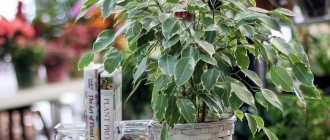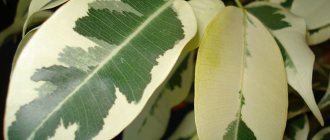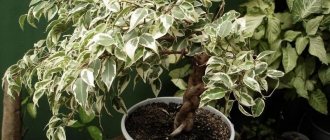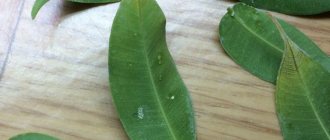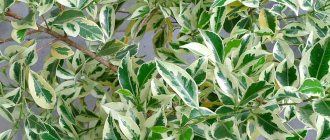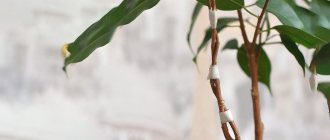The ever-popular houseplants, ficus trees, belong to the fig genus. Hundreds of species of ficus are native to the tropics, including Asia, America and Africa. These are ornamental, food and even religious plants; in Thailand they are a symbol of happiness and good luck. Some species of ficus are also known as fig trees and produce well-known fruits.
- Why is Ficus Benjamin so popular?
- Ficus benjamina plant varieties
- How to grow ficus benjamina Lighting for ficus benjamina
- Soil for ficus benjamina
- Rules for watering Ficus Benjamin
- Temperature and humidity for ficus benjamina
- Fertilizers for Ficus Benjamin
- Planting and replanting Ficus Benjamin
- Reproduction of Ficus Benjamin
- Pruning ficus benjamina
Why is Ficus Benjamin so popular?
Ficus benjamina, or weeping fig (Ficus benjamina), tropical laurel, Java fig, Java tree - a small-leaved rubber plant in its homeland, has curved stems with shiny green or variegated, variegated leaves. At home, some varieties grow into a small elegant tree, reaching 1.5 - 2.0 m in height.
Although ficus plants have special growing requirements, few plants are as adaptable to apartment conditions. And the favorite among growers is Ficus Benjamin, since the plant is excellent for beginners in bonsai culture; its shoots can be braided, and by cutting and grafting they can be given a spherical and standard shape.
Ficus benjamina
Interesting Facts
- Ficus benjamina is the symbol tree of Bangkok, the capital of Thailand.
- Often, to give thickness and texture to the trunk of a plant when grown for decorative purposes, 2-3 plants are planted together and their trunks are woven into a braid or strand. As they grow, the trunks grow together and form beautiful growths.
- In the Royal Botanical Gardens in Peradeniya, Sri Lanka, there is a ficus tree that is 150 years old and has a crown area of 25 square meters. Local residents gave it the name “Turtle” due to the similarity of the crown shape with this animal
Sources and literature
Ficus benjamina plant varieties
In nature, Ficus benjamina has narrow, glossy green leaves. Decorative species include the variegated ficus Bendazhmina (F. benjamina variegata) - it has rather pale green leaves with creamy white edges.
Varieties differ mainly in size, shape, color and variegation of leaves.
Ficus benjamina Anastasia
Anastasia - variegated leaf color with a wide light green uneven edge and a central vein of the same shade, the edges of the leaves are uneven. Variegation does not disappear with age.
Ficus benjamina Barok
Barok - Glossy green leaves curl around an arched vein. They grow from 3 cm to 4 cm in length, and up to 2 cm in width. For a more spectacular spectacle, Ficus Barok is recommended to plant several plants in one pot.
Ficus benjamina wiandi
Wiandi is a small plant with thin branches and medium-sized leaves, easily grown in bonsai culture. A distinctive feature of this variety is the trunk rotated 90 degrees.
Ficus benjamina Kinky
Kinky is a very compact ficus, no more than 40 cm high. The leaves are narrow, with multi-colored edges of green and cream.
Natasja - ficus Natasha is a miniature tree that has gained wide popularity thanks to the ability to braid its branches (for this, several plants are planted together). The leaves are slightly elongated, monochromatic.
Ficus benjamina Danielle
Danielle - this variety can reach a height of up to 2 meters. Dense, shiny foliage, light to dark green.
Variety of leaf colors of ficus benjamina varieties
De Gantel - the foliage color is predominantly white, with very wide variegation. The variety needs to be handled with care - it burns strongly in bright sun, and suffers from a lack of chlorophyll in the absence of lighting.
Ficus benjamina Golden King
Golden King - the leaves are long, about 7 cm, have slightly wavy edges and lemon-green variegation.
Ficus benjamina Starlight
Starlight - leaves with wide white variegation, growth is moderate.
Ficus benjamina Twilight
Twilight - variegated border is narrow, irregular in shape and can have different widths. The center of the leaf blade is green.
Pests
White lumps on the leaves are a sign of mite activity. Prevention - regular inspection of the plant and isolation of the ficus from other indoor flowers that may be affected by the pest. For treatment, industrially produced insecticidal solutions should be used.
If small uneven holes appear on the stems and leaves, it means that the flower is being nibbled by a bug. To cope with the pest, you can spray the plant with a solution of laundry soap. For prevention, it is necessary to promptly remove yellowed leaves and deformed shoots, because they are a tasty morsel for the scale insect.
Curled dry leaves are a sign of scale insects. Prevention - regular watering and frequent fertilizing. Control measures are to collect the scale insects by hand and burn the affected leaves, and then transplant the plant into another pot.
How to grow ficus benjamina
Many beginners are disappointed with Ficus Benjamin. Plants are prone to leaf loss in drafts and cold weather and do not like change. Ficus trees are also vulnerable to mites, mealybugs, whiteflies and aphids. As tropical plants, they need adequate light, warmth and humidity to look their best. However, the availability of ficus in garden centers and relatively modest prices make it possible to repeat attempts to grow a beautiful plant again and again.
So, the main tips for successfully growing Ficus Benjamin:
1 Move your Ficus Benjamin as little as possible. Ficus is very sensitive to changes in temperature, humidity, light and other factors, and even the slightest change can cause the leaves to fall. Therefore, it is best to immediately find the ideal place for the ficus and leave it there.
2 Over time, most Ficus benjamina varieties become large plants, so allow plenty of space. Ficus plants tend to lean towards the light, so rotate the plant from time to time to achieve a symmetrical crown. If you do have to move your ficus or take it outside during the warmer months, it may take a few weeks for the plant to recover from the move, but it will survive.
3 A common problem with Ficus benjamina is that it reacts sensitively to any stress, losing all its leaves. Stress can be caused by many things, including overwatering, lack of light, low humidity, temperature changes, drafts or pest infestations. Don't worry, Benjamin's ficus trees usually regrow their leaves.
Ficus benjamina Natasja
Ficus crown formation
Ficus benjamina itself has a beautiful crown; many varieties do not require any special shaping. However, if the ficus trunk is bare, you can stimulate the formation of new shoots and leaves by pruning. To do this, you can cut off part of the shoots, completely or partially; sometimes it is enough to pinch the tips of the lower branches so that new buds begin to grow. Pruning should be done in spring - early summer. The younger the ficus tree, the easier it is to shape by pruning.
In addition to pruning and pinching, the crown of ficus trees is formed by bending it with wire (to form bonsai and pre-bonsai). Ficus shoots are quite flexible and bend easily, but the thin bark can crack or peel off from the wire, so it is applied loosely and braided wire is used. There should be a gap between the wire and the ficus stems - after all, the plant grows and the branches gain thickness; if the wire is wound tightly, the wire will eventually grow into the bark.
Ficus Baroque is formed using wire; the flexible trunks of the ficus can be bent quite steeply, trying to achieve the chosen bonsai style.
If you are forming a ficus by merging the trunk, then when braiding a pigtail from several trunks, be sure to leave gaps between them so that the trunks can grow in thickness. Drawing by Vitaly Alenkin.
Merging trunks - several rooted cuttings are planted close to each other and wrapped with electrical tape. Part of the electrical tape has been removed and the joints of the trunks are clearly visible. Further shaping is required.
Cuttings of some varieties of ficus benjamin branch reluctantly; single branches look and gain strength slowly, they can stretch upward, even with sufficient lighting, and begin to branch, reaching approximately 30-40 cm in height. Therefore, it is worth pinching and cutting the cuttings at a height of approximately 20 cm.
You can plant several cuttings in a pot and, if the stems are pressed tightly against each other, then in a very short time they grow together. You can bring the stems of ficus cuttings closer together using ordinary electrical tape - it is quite flexible and does not injure the bark; it stretches on the growing trunks without growing. About once a month you need to inspect the braid and rewind it if necessary. It is better, of course, for trunks of small diameter, 5-7 mm, to grow together, but thicker ones can also be fused, but the process will take several years.
Another way of forming is to intertwine the trunks with a pigtail or in the manner of a hedge - openwork weaving from the trunks of ficus benjamina. This method is only suitable for young flexible plants. In this case, several large cuttings must be planted in one elongated container at a distance of 5 to 10 cm from each other, strictly in a row. Initially, each trunk grows vertically and is formed into a standard (all lower branches are removed). At approximately a height of 20-25 cm, ficuses can be fixed, tilted, crossing the trunks with each other. Secure with electrical tape or jute.
Lighting for Ficus Benjamin
Ficus benjamina requires bright light, but only single plants can withstand direct sun. They like to be taken outside in the summer, but not placed in direct sunlight. Bright, direct light will burn the leaves and cause them to fall off.
The ideal place for ficus is a well-lit place that does not receive a lot of direct sunlight.
In winter, a warm and bright room is ideal for ficus. During the warmer summer months, you can move the plant to a bright balcony or patio if there is plenty of afternoon shade.
Photos in the interior
Ficus benjamina is a luxurious spreading tree that attracts attention with the elegance of its branches and the density of its crown. With proper care, the ficus birch tree will become a real decoration for your home collection, capable of refreshing the interior of a city apartment even on its own.
Soil for ficus benjamina
Ficus needs well-drained, fertile soil. Soil mixtures should work well for this plant and provide it with the nutrients it needs. Do not use rose or azalea soil as these are more acidic potting soils. Fill in potting soil around the plant with compost and a small amount of perlite or vermiculite for added drainage.
You can find out how to improve soil for indoor plants here >>>
Ficus benjamina variegata
Ficus variegated green with green
Unusual and spectacular representatives of ficus Benjamin, combining in their colors two shades of green - bright, rich and dark. The differences between these varieties are determined by the size of the leaves and the total area of dark inclusions. As a rule, inclusions are not located randomly, but in a spot from the center of the sheet with uneven, clearly defined edges.
Ficus Anastasia
Quite large, up to 8 cm leaves with a slightly wavy edge. The color is rich green with an uneven bright yellow-light green border along the edge and a pronounced central vein of the same color.
Ficus benjamina Anastasia (Ficus Anastasia)
Ficus Golden Monique
A variegated variety of the Monique variety - bright green light leaves with a dark green uneven spot in the center.
Ficus Golden Monique
Rules for watering Ficus Benjamin
Water your ficus benjamina evenly throughout the summer and reduce watering in winter. In dry homes, provide adequate moisture by misting the leaves frequently. Don't let the root ball dry out and check the soil before watering.
Water the plant when the soil is dry to the depth of a knuckle. Overwatering can be a big problem for ficus plants. When the plant is in its growth phase (spring and summer), water it regularly, but do not overwater it. Allow the top layer of soil to dry out between waterings.
Overwatering can cause leaves to curl or darken or fall off.
In fall and winter, water the plant less frequently and allow the soil to dry out to a depth of several centimeters before watering.
Air humidification in winter is mandatory for ficuses (Ficus benjamina Samantha)
Useful properties of the plant
Ficus benjamina in the house is the key to clean air. Its leaves absorb harmful substances such as phenol and benzene. And, thanks to the special juice contained in the plant, they are converted into sugars and amino acids.
This type of ficus also has medicinal properties. In their homeland, tinctures, ointments and decoctions from its leaves have been used for treatment since ancient times. Currently, its ability to heal has been noticed in Europe and the USA.
It is used to make medicines to treat various diseases. Many have already included it in the list of plants for their home pharmacy.
In folk medicine it is used as follows:
- in the form of lotions and decoctions for the treatment of various tumors;
- in the form of lotions from the juice of the leaves for the treatment of mastopathy;
- as an internal remedy from milk and plant juice to activate the liver;
- as an internal remedy of water and leaf juice to treat headaches;
- in the form of a poultice from the pulp of the leaves to treat rheumatism.
Interesting! It is believed that Ficus Benjamin has a beneficial effect on space and on an energy level. It is recommended to purchase it for those whose business, despite all their efforts, is completely stagnant. And also to those who believe that there is a lot of evil and envy around them.
Temperature and humidity for ficus benjamina
These plants do not tolerate low temperatures and drafts. Constantly maintain the temperature within +16…+24 °C. In summer, the most optimal temperature will be +23 °C ... +25 °C. In winter it likes moderate warmth - +12 °C...+15 °C. Any drafts from windows, doors or air conditioners can harm the plant. Keep ficus trees away from drafts. Ficus does not like sudden changes in temperature and will most likely shed its leaves if exposed to freezing temperatures. Ideally, the plant should never be exposed to temperatures below +10 °C.
Because Ficus benjamina is native to tropical climates, it tends to grow best in a slightly moist environment. The ideal humidity for a ficus plant is between 50 and 70%, and keeping it drier may cause the leaves to drop.
To increase humidity, consider installing a portable humidifier near the plant or misting the plant and air daily. Ficus benjamina does not like dry air, keep it away from vents, air exchangers, radiators, and heaters. Mist the leaves regularly or place a pebble tray filled with water under the plant.
Poisonous or not for humans and pets
The roots, stems and leaves of ficus do not contain toxic substances that can have a negative impact on the health of humans or animals, such as dogs or cats. The plant does not cause allergic reactions and is absolutely safe to grow. It can be planted in the living room, bedroom or kitchen. Ficus has rather hard leaves, so cats that often gnaw on indoor plants are likely to show interest in it.
It is certainly worth growing ficus benjamina at home. It will not only decorate the interior, but also help clean the air in the apartment from harmful impurities. If you believe good signs, a ficus in the house will help attract money and success, and will also bring harmony to family relationships. The main thing is to choose the most unpretentious varieties. However, this flower is not suitable for small apartments, as it grows quickly and can “eat up” the space.
Fertilizers for Ficus Benjamin
Feed Ficus benjamina with slow-release granules early in the growing season. These plants grow quickly and you will see benefits from monthly fertilization in the spring and summer and bimonthly in the fall.
Between late spring and early fall, fertilize your ficus every two to four weeks to encourage healthy leaf growth and prevent leaf yellowing. Mix a small amount of liquid fertilizer and water and feed the plant to keep it healthy throughout the growing season.
You can find long-lasting fertilizers for indoor plants here >>>
Ficus transplant
Home care
The main requirement for care and maintenance at home is the presence of a large, spacious pot and regular replanting, since the ficus has a developed root system that grows very quickly. You should also pay attention to the watering regime. The soil in the pot should always be a little moist (but not too much).
The list of basic measures for caring for ficus includes:
- watering;
- fertilizing;
- transfer;
- pruning and crown formation.
It should be borne in mind that improper pruning can lead to deformation of the tree and deteriorate the appearance of the crown.
Priming
Regular soil for indoor plants is suitable for growing. It is necessary to lay a drainage layer of expanded clay at the very bottom of the pot so that excess moisture comes out, otherwise the earth will rot. You can add eggshells to the soil as a mineral fertilizer.
Tara
You can use a ceramic or plastic flower pot of any shape. The main thing is that it freely accommodates the powerful root system of the ficus. The plant grows quickly, and replanting is recommended at least once every three years. The pot must first be disinfected so that the plant does not get sick.
Watering
Ficus is a moisture-loving flower, so the optimal frequency of watering is once every three days. As soon as the soil has dried 2 cm deep, it is time to water again. In summer, watering should be done more often than in winter. If the top layer has not yet dried out, you need to wait a while with watering, otherwise you can create dampness in the ground and infect the ficus with a fungus, which is then very difficult to treat. The water should be at room temperature, pre-settled. It is strictly forbidden to water the flower with tap water; it has a detrimental effect on the root system and the general condition of the flower. Excess water must be drained from the pan in time.
Fertilizer (feeding)
The optimal time for fertilizing is from April to October; in the spring it is enough to fertilize the ficus once a month, and in June once every two weeks, because in the summer there is a peak of active growth and development. In winter, the flower is at rest; it does not need to be fertilized, but you can add eggshells and drunken tea as sources of calcium and potassium. Fertilizers are applied both at the root and on the leaves and stem - from a spray bottle.
The use of folk remedies gives good results. You can dilute two tablespoons of granulated sugar in 2 liters of water at room temperature and pour the ficus under the root from a watering can. Glucose stimulates plant growth. This fertilizer can be used once a month in the summer.
Trimming
Many varieties of ficus, especially those with spiral leaves, grow very quickly. If the excess shoots are not trimmed in time, they will grow chaotically, and the flower will take on an unkempt, neglected appearance. Therefore, young growth should be removed regularly. When pruning, you should not hesitate to remove dead branches, starting from the bottom and gradually moving up. Remove all wilted and dry leaves, as well as excess young growth. Ultimately, the crown should take on a spherical or oval shape.
Transfer
To replant, the flower is pulled out of the pot along with a lump of earth and transferred to another pre-prepared pot with a nutritious substrate for indoor plants. All resulting voids are carefully covered with earth, trying not to touch the leaves and stem. If the room is cold, you should refrain from watering for a couple of days. If the house is warm, you can immediately after transplanting, spray the plant with warm water from a spray bottle, but do not water it at the root.
Formation
To form a crown at home, pinch the top of the flower. All unnecessary branches are removed. The foliage at the top should be denser than at the bottom.
Rejuvenation
Rejuvenation is resorted to when the foliage begins to fall, and signs of dieback are visible at the top. In this case, you just need to carefully trim the plant so that only one stump remains. After this, young shoots will begin to appear quickly, and the vitality of the plant will be restored. But this method is stressful for the plant, so pruning must be done carefully; For three days from the moment of rejuvenation, you should refrain from watering and make sure that there are no drafts in the room.
Planting and replanting Ficus Benjamin
A healthy ficus benjamina will quickly outgrow both the pot and your house (unless the variety is characterized by compact dimensions). Repot every two to three years to slow growth and maintain a manageable plant size. Always use good quality soil when replanting. Young ficus trees are transplanted in early spring - in March, every year. Large varieties and species plants need to increase the diameter of the pot by 4 cm. For an adult plant, it is enough to replace the top layer of soil.
To replant a ficus:
- Choose a pot that is one size larger (about 5cm in diameter) than your current one.
- Fill the pot halfway with fresh, well-drained potting mix.
- Carefully remove the ficus from the pot.
- Place the ficus in a new pot.
- Cover the roots and lower part of the stem with enough soil without deepening the root collar.
- Water the plant.
Brief description of cultivation
- Temperature . In summer, the optimal temperature for the growth and development of shrubs is 18–25 degrees. In the winter months, you can move the bush to a cooler place (not lower than 16 degrees).
- Air humidity . The bush needs high air humidity. In this regard, it should be systematically moistened with a spray bottle. Particular attention should be paid to spraying in winter, when due to operating heating devices the air humidity drops very low.
- Illumination . The bush grows well on a sunny windowsill, but it is recommended to protect it from direct sunlight. In winter, it is recommended to organize lighting.
- Watering . Moisten the substrate in the pot systematically: in the summer - twice a week, and in the winter - once every 7 days. Make sure that the surface of the soil mixture dries out between waterings.
- Soil mixture . The nutrient substrate should include components such as sand, leaf and turf soil, and a small amount of charcoal.
- Fertilizer . Ficus feeding is carried out from spring to autumn. To do this, use liquid fertilizer, and add it to the substrate twice a month. Experienced gardeners recommend feeding the bush alternately with organic matter and mineral fertilizers.
- Transplant . While the shrub is young, it is replanted annually. An adult plant can do without replanting, but it must be planted in a pot measuring more than 30 centimeters in diameter. In this case, he only replaces the top layer of substrate 30 mm thick every year.
- Reproduction . By apical cuttings, layering and seed method.
- Trimming . There are several ways to trim ficus, with which the crown of the bush can be given a standard or bush-like shape.
Ficus Benjamin in indoor conditions. Care, watering, review
Reproduction of Ficus Benjamin
Ficus can be rooted from apical cuttings using rooting hormone. Use only non-lignified stems as cuttings. For larger plants, the preferred method is propagation by air layering.
Wear gloves as the plant produces an irritating sap when cut.
You can find out how to take ficus cuttings and quickly propagate in this material >>>>
Ficus cuttings
Pruning ficus benjamina
If your ficus is overgrown, don't be afraid to prune it. New leaves will sprout quickly. Trim the ficus so that it maintains its shape and does not touch the ceiling. Pruning should be done at the very beginning of spring, when it is not actively growing. Wear gloves and use sharp pruning scissors. Make the cut just before a node to encourage dormant buds to awaken and begin new growth.
You can cut dry, thin shoots (without leaves) with small pruners or scissors.
Why does ficus shed its leaves?
First of all, understand that it is normal for your ficus to lose leaves; it is a typical stripper. This may be due to the following reasons:
Changes in habitat are the most common cause of ficus leaves falling, including when the seasons change. The humidity and temperature in your home also change during this time, and this can cause your ficus tree to lose its leaves. In this case, the leaves on the ficus first turn yellow. To help with this, try to keep your ficus's environment as stable as possible.
Improper watering – under-watering or over-watering can cause your ficus plant to lose its leaves. They turn yellow and curl. Only water the soil when the topmost part of the soil is dry, but also make sure that your ficus pot has good drainage. If you accidentally let your ficus soil dry out completely, you may need to soak the tree container in a bathtub for an hour to properly moisten the soil.
If you have given your ficus too much water, root rot may have set in and you will need to dry out the plant.
Too little light is another reason for ficus leaves to fall off; in this case, the plant has a sparse crown and thin shoots. New leaves may also appear pale. In this case, you should move the ficus to a place where it will get more light.
Pests – Ficus trees are susceptible to several pests. Often a telltale sign of a pest problem will be if your ficus leaves are sticky or dripping or falling off liquid. If this is a problem, you will need to treat the plant with an insecticide. Ficus leaves fall and when affected by a fungal infection, then yellow or brown spots appear on the leaves. In this case, use a fungicide.
You can learn more about why plants shed leaves here >>>
Problems during cultivation
Inexperienced indoor plant lovers often encounter serious problems when growing ficus. However, these problems can be successfully solved and prevented. Most often, ficus owners complain about the following difficulties in caring for their flowers:
- yellow leaves;
- leaves soften
- new shoots become thinner;
- leaves wilt and curl for no apparent reason.
Most often this occurs due to a lack of moisture, nutrients and microelements. But there are other reasons.
Leaves wither and curl
It happens that the leaves suddenly begin to wither, and then curl and fall off. This happens because the plant lacks nutrients. To solve the problem, it is necessary to apply fertilizing. For prevention, you should trim the flower and form a crown, then the plant will spend its energy not on the formation of new shoots, but on feeding existing ones.
The tips of the leaves turn brown
If the tips of the leaves become brown or brown, it means that the roots of the flower have begun to rot. It is necessary to replant the plant after cutting off the affected roots. Prevention - regular loosening of the soil to prevent stagnation of moisture.
New shoots are thin
As the trunk forms, new shoots appear. If they are very thin and break quickly, the plant lacks microelements. The method of solution and prevention is quite simple - it is necessary to fertilize according to the season, paying special attention to fertilizers that contain calcium and magnesium.
The leaves are turning yellow
If the leaves turn yellow and then fly off, this is a sure sign of potassium deficiency. To solve and prevent the problem, it is necessary to fertilize with potassium fertilizers. Regular ash is also good; it is rich in potassium and other nutrients, and is also completely harmless. However, if the ficus has already turned completely yellow, it may not be possible to save it; Massive yellowing and falling of leaves is a sign of a root infection. In this case, a transplant can be performed, but it will also not guarantee salvation.
The leaves are falling
It happens that a flower drops its lower leaves. This happens due to moisture deficiency. To solve and prevent the problem, it is necessary to establish regular watering and not skip it. You should also give the plant a “shower” by spraying the leaves and stem with a spray bottle.
Leaves are soft
Soft leaves appear when there is a vitamin deficiency. To solve the problem, it is necessary to increase the amount of light in the room (perhaps move the ficus or place a lamp next to it as an additional light source). For prevention, it is necessary to regularly fertilize and ensure that the plant has enough light.
Yellow and brown spots on leaves
If yellow and brown spots appear on the leaves, this is a serious disease - viral mosaic. For treatment, it is necessary to transplant the plant into another pot with previously prepared soil, cut off and burn all affected leaves. Prevention - regular feeding and normalization of room temperature.
Sticky leaves
If the leaves are sticky, it means the plant has a fungal infection. Prevention - moderate moisture and regular loosening of the soil, adjusting the air humidity in the room. Treatment is transplantation into another pot, treatment with fungicides.
White plaque
It happens that an unpleasant and unsightly white coating appears on the leaves closer to the crown; such leaves become sticky and sticky to the touch. Most likely, such a plant is affected by aphids. Prevention - regular loosening of the soil and reducing watering. Aphids do not like tobacco smoke, so preventative fumigation is recommended.
Tips for buying ficus benjamina
- Choose a healthy plant with lush leaves. Check for sap at the tips of the shoots, which may indicate recent pruning or pest activity.
- Make sure you have enough space for your plant as it can reach 2.0m in height.
- The best time to buy a ficus is spring, when temperature and humidity are optimal.
- Research carefully what your ficus tree needs to grow and make sure you have the right conditions.
Find more tips for buying indoor plants here >>>



